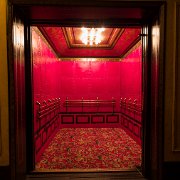
1 The Detroit Fox is one of five spectacular Fox Theatres built in the late 1920s by film pioneer William Fox. The others were the Fox Theatres in Brooklyn, Atlanta, St. Louis, and San Francisco. Architect C. Howard Crane designed the Fox with a lavish interior featuring a blend of Burmese, Chinese, Indian and Persian motifs. There are three levels of seating, the Main Floor above the orchestra pit, the Mezzanine, and the Gallery (balcony). The exterior of the attached 10-story office building features a façade with Asian motifs which, when illuminated at night, can be seen for several blocks. The Fox Theatre in St. Louis, Missouri is (on the interior) its near architectural twin with about 500 fewer seats. The 10-story Detroit Fox Theatre building also contains the headquarters of Olympia Entertainment, while the St. Louis Fox is a stand-alone theatre. The architectural plaster molds of the Detroit Fox (1928) were re-used on the St. Louis Fox (1929).
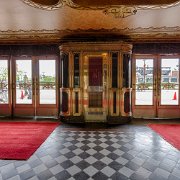
2 The Detroit Fox is one of five spectacular Fox Theatres built in the late 1920s by film pioneer William Fox. The others were the Fox Theatres in Brooklyn, Atlanta, St. Louis, and San Francisco. Architect C. Howard Crane designed the Fox with a lavish interior featuring a blend of Burmese, Chinese, Indian and Persian motifs. There are three levels of seating, the Main Floor above the orchestra pit, the Mezzanine, and the Gallery (balcony). The exterior of the attached 10-story office building features a façade with Asian motifs which, when illuminated at night, can be seen for several blocks. The Fox Theatre in St. Louis, Missouri is (on the interior) its near architectural twin with about 500 fewer seats. The 10-story Detroit Fox Theatre building also contains the headquarters of Olympia Entertainment, while the St. Louis Fox is a stand-alone theatre. The architectural plaster molds of the Detroit Fox (1928) were re-used on the St. Louis Fox (1929).
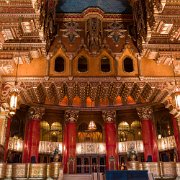
3 The Detroit Fox is one of five spectacular Fox Theatres built in the late 1920s by film pioneer William Fox. The others were the Fox Theatres in Brooklyn, Atlanta, St. Louis, and San Francisco. Architect C. Howard Crane designed the Fox with a lavish interior featuring a blend of Burmese, Chinese, Indian and Persian motifs. There are three levels of seating, the Main Floor above the orchestra pit, the Mezzanine, and the Gallery (balcony). The exterior of the attached 10-story office building features a façade with Asian motifs which, when illuminated at night, can be seen for several blocks. The Fox Theatre in St. Louis, Missouri is (on the interior) its near architectural twin with about 500 fewer seats. The 10-story Detroit Fox Theatre building also contains the headquarters of Olympia Entertainment, while the St. Louis Fox is a stand-alone theatre. The architectural plaster molds of the Detroit Fox (1928) were re-used on the St. Louis Fox (1929).
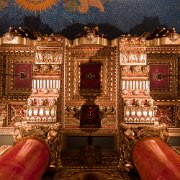
4 The Detroit Fox is one of five spectacular Fox Theatres built in the late 1920s by film pioneer William Fox. The others were the Fox Theatres in Brooklyn, Atlanta, St. Louis, and San Francisco. Architect C. Howard Crane designed the Fox with a lavish interior featuring a blend of Burmese, Chinese, Indian and Persian motifs. There are three levels of seating, the Main Floor above the orchestra pit, the Mezzanine, and the Gallery (balcony). The exterior of the attached 10-story office building features a façade with Asian motifs which, when illuminated at night, can be seen for several blocks. The Fox Theatre in St. Louis, Missouri is (on the interior) its near architectural twin with about 500 fewer seats. The 10-story Detroit Fox Theatre building also contains the headquarters of Olympia Entertainment, while the St. Louis Fox is a stand-alone theatre. The architectural plaster molds of the Detroit Fox (1928) were re-used on the St. Louis Fox (1929).

5 The Detroit Fox is one of five spectacular Fox Theatres built in the late 1920s by film pioneer William Fox. The others were the Fox Theatres in Brooklyn, Atlanta, St. Louis, and San Francisco. Architect C. Howard Crane designed the Fox with a lavish interior featuring a blend of Burmese, Chinese, Indian and Persian motifs. There are three levels of seating, the Main Floor above the orchestra pit, the Mezzanine, and the Gallery (balcony). The exterior of the attached 10-story office building features a façade with Asian motifs which, when illuminated at night, can be seen for several blocks. The Fox Theatre in St. Louis, Missouri is (on the interior) its near architectural twin with about 500 fewer seats. The 10-story Detroit Fox Theatre building also contains the headquarters of Olympia Entertainment, while the St. Louis Fox is a stand-alone theatre. The architectural plaster molds of the Detroit Fox (1928) were re-used on the St. Louis Fox (1929).
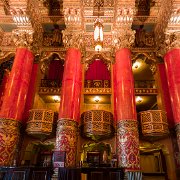
6 The Detroit Fox is one of five spectacular Fox Theatres built in the late 1920s by film pioneer William Fox. The others were the Fox Theatres in Brooklyn, Atlanta, St. Louis, and San Francisco. Architect C. Howard Crane designed the Fox with a lavish interior featuring a blend of Burmese, Chinese, Indian and Persian motifs. There are three levels of seating, the Main Floor above the orchestra pit, the Mezzanine, and the Gallery (balcony). The exterior of the attached 10-story office building features a façade with Asian motifs which, when illuminated at night, can be seen for several blocks. The Fox Theatre in St. Louis, Missouri is (on the interior) its near architectural twin with about 500 fewer seats. The 10-story Detroit Fox Theatre building also contains the headquarters of Olympia Entertainment, while the St. Louis Fox is a stand-alone theatre. The architectural plaster molds of the Detroit Fox (1928) were re-used on the St. Louis Fox (1929).
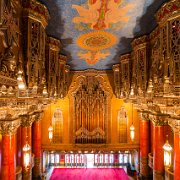
7 The Detroit Fox is one of five spectacular Fox Theatres built in the late 1920s by film pioneer William Fox. The others were the Fox Theatres in Brooklyn, Atlanta, St. Louis, and San Francisco. Architect C. Howard Crane designed the Fox with a lavish interior featuring a blend of Burmese, Chinese, Indian and Persian motifs. There are three levels of seating, the Main Floor above the orchestra pit, the Mezzanine, and the Gallery (balcony). The exterior of the attached 10-story office building features a façade with Asian motifs which, when illuminated at night, can be seen for several blocks. The Fox Theatre in St. Louis, Missouri is (on the interior) its near architectural twin with about 500 fewer seats. The 10-story Detroit Fox Theatre building also contains the headquarters of Olympia Entertainment, while the St. Louis Fox is a stand-alone theatre. The architectural plaster molds of the Detroit Fox (1928) were re-used on the St. Louis Fox (1929).
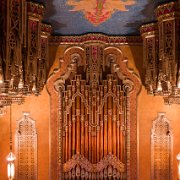
8 The Detroit Fox is one of five spectacular Fox Theatres built in the late 1920s by film pioneer William Fox. The others were the Fox Theatres in Brooklyn, Atlanta, St. Louis, and San Francisco. Architect C. Howard Crane designed the Fox with a lavish interior featuring a blend of Burmese, Chinese, Indian and Persian motifs. There are three levels of seating, the Main Floor above the orchestra pit, the Mezzanine, and the Gallery (balcony). The exterior of the attached 10-story office building features a façade with Asian motifs which, when illuminated at night, can be seen for several blocks. The Fox Theatre in St. Louis, Missouri is (on the interior) its near architectural twin with about 500 fewer seats. The 10-story Detroit Fox Theatre building also contains the headquarters of Olympia Entertainment, while the St. Louis Fox is a stand-alone theatre. The architectural plaster molds of the Detroit Fox (1928) were re-used on the St. Louis Fox (1929).
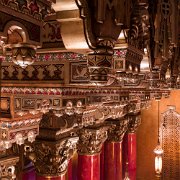
9 The Detroit Fox is one of five spectacular Fox Theatres built in the late 1920s by film pioneer William Fox. The others were the Fox Theatres in Brooklyn, Atlanta, St. Louis, and San Francisco. Architect C. Howard Crane designed the Fox with a lavish interior featuring a blend of Burmese, Chinese, Indian and Persian motifs. There are three levels of seating, the Main Floor above the orchestra pit, the Mezzanine, and the Gallery (balcony). The exterior of the attached 10-story office building features a façade with Asian motifs which, when illuminated at night, can be seen for several blocks. The Fox Theatre in St. Louis, Missouri is (on the interior) its near architectural twin with about 500 fewer seats. The 10-story Detroit Fox Theatre building also contains the headquarters of Olympia Entertainment, while the St. Louis Fox is a stand-alone theatre. The architectural plaster molds of the Detroit Fox (1928) were re-used on the St. Louis Fox (1929).
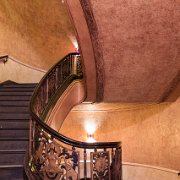
10 The Detroit Fox is one of five spectacular Fox Theatres built in the late 1920s by film pioneer William Fox. The others were the Fox Theatres in Brooklyn, Atlanta, St. Louis, and San Francisco. Architect C. Howard Crane designed the Fox with a lavish interior featuring a blend of Burmese, Chinese, Indian and Persian motifs. There are three levels of seating, the Main Floor above the orchestra pit, the Mezzanine, and the Gallery (balcony). The exterior of the attached 10-story office building features a façade with Asian motifs which, when illuminated at night, can be seen for several blocks. The Fox Theatre in St. Louis, Missouri is (on the interior) its near architectural twin with about 500 fewer seats. The 10-story Detroit Fox Theatre building also contains the headquarters of Olympia Entertainment, while the St. Louis Fox is a stand-alone theatre. The architectural plaster molds of the Detroit Fox (1928) were re-used on the St. Louis Fox (1929).
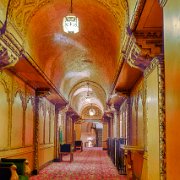
11 The Detroit Fox is one of five spectacular Fox Theatres built in the late 1920s by film pioneer William Fox. The others were the Fox Theatres in Brooklyn, Atlanta, St. Louis, and San Francisco. Architect C. Howard Crane designed the Fox with a lavish interior featuring a blend of Burmese, Chinese, Indian and Persian motifs. There are three levels of seating, the Main Floor above the orchestra pit, the Mezzanine, and the Gallery (balcony). The exterior of the attached 10-story office building features a façade with Asian motifs which, when illuminated at night, can be seen for several blocks. The Fox Theatre in St. Louis, Missouri is (on the interior) its near architectural twin with about 500 fewer seats. The 10-story Detroit Fox Theatre building also contains the headquarters of Olympia Entertainment, while the St. Louis Fox is a stand-alone theatre. The architectural plaster molds of the Detroit Fox (1928) were re-used on the St. Louis Fox (1929).
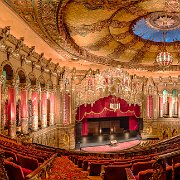
12 The Detroit Fox is one of five spectacular Fox Theatres built in the late 1920s by film pioneer William Fox. The others were the Fox Theatres in Brooklyn, Atlanta, St. Louis, and San Francisco. Architect C. Howard Crane designed the Fox with a lavish interior featuring a blend of Burmese, Chinese, Indian and Persian motifs. There are three levels of seating, the Main Floor above the orchestra pit, the Mezzanine, and the Gallery (balcony). The exterior of the attached 10-story office building features a façade with Asian motifs which, when illuminated at night, can be seen for several blocks. The Fox Theatre in St. Louis, Missouri is (on the interior) its near architectural twin with about 500 fewer seats. The 10-story Detroit Fox Theatre building also contains the headquarters of Olympia Entertainment, while the St. Louis Fox is a stand-alone theatre. The architectural plaster molds of the Detroit Fox (1928) were re-used on the St. Louis Fox (1929).
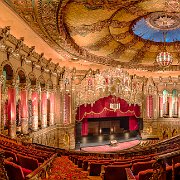
13 The Detroit Fox is one of five spectacular Fox Theatres built in the late 1920s by film pioneer William Fox. The others were the Fox Theatres in Brooklyn, Atlanta, St. Louis, and San Francisco. Architect C. Howard Crane designed the Fox with a lavish interior featuring a blend of Burmese, Chinese, Indian and Persian motifs. There are three levels of seating, the Main Floor above the orchestra pit, the Mezzanine, and the Gallery (balcony). The exterior of the attached 10-story office building features a façade with Asian motifs which, when illuminated at night, can be seen for several blocks. The Fox Theatre in St. Louis, Missouri is (on the interior) its near architectural twin with about 500 fewer seats. The 10-story Detroit Fox Theatre building also contains the headquarters of Olympia Entertainment, while the St. Louis Fox is a stand-alone theatre. The architectural plaster molds of the Detroit Fox (1928) were re-used on the St. Louis Fox (1929).
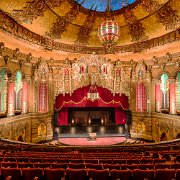
14 The Detroit Fox is one of five spectacular Fox Theatres built in the late 1920s by film pioneer William Fox. The others were the Fox Theatres in Brooklyn, Atlanta, St. Louis, and San Francisco. Architect C. Howard Crane designed the Fox with a lavish interior featuring a blend of Burmese, Chinese, Indian and Persian motifs. There are three levels of seating, the Main Floor above the orchestra pit, the Mezzanine, and the Gallery (balcony). The exterior of the attached 10-story office building features a façade with Asian motifs which, when illuminated at night, can be seen for several blocks. The Fox Theatre in St. Louis, Missouri is (on the interior) its near architectural twin with about 500 fewer seats. The 10-story Detroit Fox Theatre building also contains the headquarters of Olympia Entertainment, while the St. Louis Fox is a stand-alone theatre. The architectural plaster molds of the Detroit Fox (1928) were re-used on the St. Louis Fox (1929).

15 The Detroit Fox is one of five spectacular Fox Theatres built in the late 1920s by film pioneer William Fox. The others were the Fox Theatres in Brooklyn, Atlanta, St. Louis, and San Francisco. Architect C. Howard Crane designed the Fox with a lavish interior featuring a blend of Burmese, Chinese, Indian and Persian motifs. There are three levels of seating, the Main Floor above the orchestra pit, the Mezzanine, and the Gallery (balcony). The exterior of the attached 10-story office building features a façade with Asian motifs which, when illuminated at night, can be seen for several blocks. The Fox Theatre in St. Louis, Missouri is (on the interior) its near architectural twin with about 500 fewer seats. The 10-story Detroit Fox Theatre building also contains the headquarters of Olympia Entertainment, while the St. Louis Fox is a stand-alone theatre. The architectural plaster molds of the Detroit Fox (1928) were re-used on the St. Louis Fox (1929).

16 The Detroit Fox is one of five spectacular Fox Theatres built in the late 1920s by film pioneer William Fox. The others were the Fox Theatres in Brooklyn, Atlanta, St. Louis, and San Francisco. Architect C. Howard Crane designed the Fox with a lavish interior featuring a blend of Burmese, Chinese, Indian and Persian motifs. There are three levels of seating, the Main Floor above the orchestra pit, the Mezzanine, and the Gallery (balcony). The exterior of the attached 10-story office building features a façade with Asian motifs which, when illuminated at night, can be seen for several blocks. The Fox Theatre in St. Louis, Missouri is (on the interior) its near architectural twin with about 500 fewer seats. The 10-story Detroit Fox Theatre building also contains the headquarters of Olympia Entertainment, while the St. Louis Fox is a stand-alone theatre. The architectural plaster molds of the Detroit Fox (1928) were re-used on the St. Louis Fox (1929).

17 The Detroit Fox is one of five spectacular Fox Theatres built in the late 1920s by film pioneer William Fox. The others were the Fox Theatres in Brooklyn, Atlanta, St. Louis, and San Francisco. Architect C. Howard Crane designed the Fox with a lavish interior featuring a blend of Burmese, Chinese, Indian and Persian motifs. There are three levels of seating, the Main Floor above the orchestra pit, the Mezzanine, and the Gallery (balcony). The exterior of the attached 10-story office building features a façade with Asian motifs which, when illuminated at night, can be seen for several blocks. The Fox Theatre in St. Louis, Missouri is (on the interior) its near architectural twin with about 500 fewer seats. The 10-story Detroit Fox Theatre building also contains the headquarters of Olympia Entertainment, while the St. Louis Fox is a stand-alone theatre. The architectural plaster molds of the Detroit Fox (1928) were re-used on the St. Louis Fox (1929).
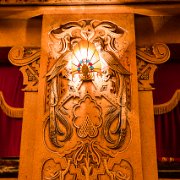
18 The Detroit Fox is one of five spectacular Fox Theatres built in the late 1920s by film pioneer William Fox. The others were the Fox Theatres in Brooklyn, Atlanta, St. Louis, and San Francisco. Architect C. Howard Crane designed the Fox with a lavish interior featuring a blend of Burmese, Chinese, Indian and Persian motifs. There are three levels of seating, the Main Floor above the orchestra pit, the Mezzanine, and the Gallery (balcony). The exterior of the attached 10-story office building features a façade with Asian motifs which, when illuminated at night, can be seen for several blocks. The Fox Theatre in St. Louis, Missouri is (on the interior) its near architectural twin with about 500 fewer seats. The 10-story Detroit Fox Theatre building also contains the headquarters of Olympia Entertainment, while the St. Louis Fox is a stand-alone theatre. The architectural plaster molds of the Detroit Fox (1928) were re-used on the St. Louis Fox (1929).
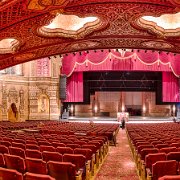
19 The Detroit Fox is one of five spectacular Fox Theatres built in the late 1920s by film pioneer William Fox. The others were the Fox Theatres in Brooklyn, Atlanta, St. Louis, and San Francisco. Architect C. Howard Crane designed the Fox with a lavish interior featuring a blend of Burmese, Chinese, Indian and Persian motifs. There are three levels of seating, the Main Floor above the orchestra pit, the Mezzanine, and the Gallery (balcony). The exterior of the attached 10-story office building features a façade with Asian motifs which, when illuminated at night, can be seen for several blocks. The Fox Theatre in St. Louis, Missouri is (on the interior) its near architectural twin with about 500 fewer seats. The 10-story Detroit Fox Theatre building also contains the headquarters of Olympia Entertainment, while the St. Louis Fox is a stand-alone theatre. The architectural plaster molds of the Detroit Fox (1928) were re-used on the St. Louis Fox (1929).
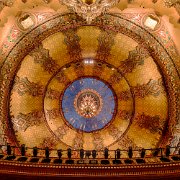
20 The Detroit Fox is one of five spectacular Fox Theatres built in the late 1920s by film pioneer William Fox. The others were the Fox Theatres in Brooklyn, Atlanta, St. Louis, and San Francisco. Architect C. Howard Crane designed the Fox with a lavish interior featuring a blend of Burmese, Chinese, Indian and Persian motifs. There are three levels of seating, the Main Floor above the orchestra pit, the Mezzanine, and the Gallery (balcony). The exterior of the attached 10-story office building features a façade with Asian motifs which, when illuminated at night, can be seen for several blocks. The Fox Theatre in St. Louis, Missouri is (on the interior) its near architectural twin with about 500 fewer seats. The 10-story Detroit Fox Theatre building also contains the headquarters of Olympia Entertainment, while the St. Louis Fox is a stand-alone theatre. The architectural plaster molds of the Detroit Fox (1928) were re-used on the St. Louis Fox (1929).
Fox Theater